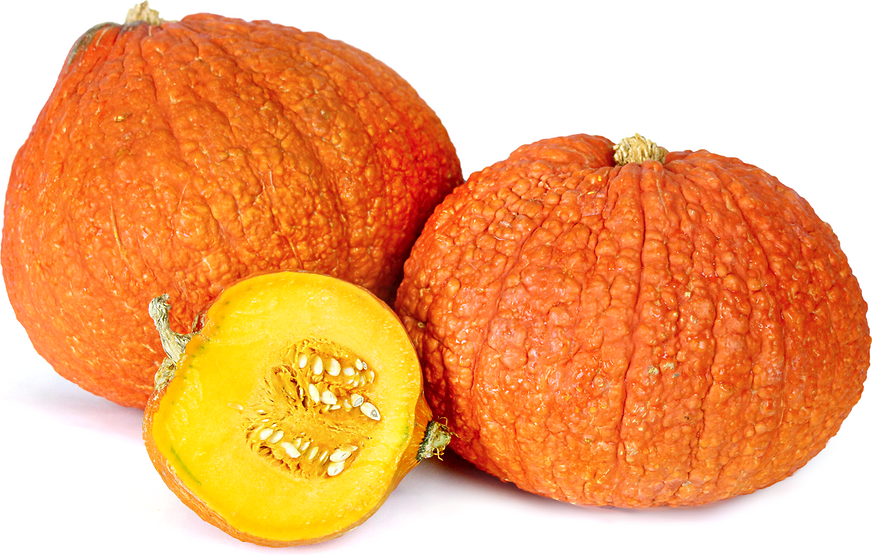


Red Warty Thing Squash
Estimated Inventory, lb : 0
Description/Taste
Red Warty Thing squash is medium to large in size, averaging 10-20 pounds, and is globular, oblong, and slightly lopsided in shape. The thick, bright orange-red skin is covered in many bumps or warts, and the number of bumps varies per squash. The fine-grained flesh is orange, dense and firm with a string-less texture, and it encases a central cavity filled with pulp and many small, flat, cream-colored seeds. When cooked, Red Warty Thing squash is tender and smooth with a mild, sweet flavor.
Seasons/Availability
Red Warty Thing squash is available in the late fall through winter.
Current Facts
Red Warty Thing squash, botanically classified as Cucurbita maxima, is a winter variety that grows on long trailing vines that can reach up to four meters in length and is a member of the Cucurbitaceae family along with pumpkins and gourds. Believed to be a cross between an ordinary pumpkin and a red hubbard squash, this heirloom squash dates back to 1897 when it was first introduced under the name victor. Over time, the squash began to fade in popularity due to the introduction of modern varieties, but the seeds were stored in the United States Seed Bank for preservation. The squash was recently reintroduced to the market in the early 2000s and was renamed Red Warty Thing squash due to its bright orange-red skin and bumpy skin texture. Red Warty Thing squash is favored for its use as an ornamental decoration, its mild flavor, and its smooth texture.
Nutritional Value
Red Warty Thing squash contains some beta-carotene, vitamins A and C, calcium, and potassium.
Applications
Red Warty Thing squash is best suited for cooked applications such as roasting, baking, pureeing, steaming, and boiling. The rind is extremely thick and difficult to cut, so care should be taken when slicing the squash. When cooked, the Red Warty Thing squash can be pureed and used for desserts such as muffins, cakes, tarts, custards, puddings, and bread. It can also be cubed, roasted, or boiled and used pasta, risotto, stews, casseroles, and curries. Red Warty Thing squash pairs well with apples, arugula, spinach, shallots, onions, garlic, herbs and spices such as sage, parsley, cilantro, thyme, and rosemary, honey, brown sugar, butter, coconut milk, meats such as chicken, ground turkey, and spiced sausage, ricotta, and parmesan cheese. It will keep up to five months when stored whole in a cool and dry place.
Ethnic/Cultural Info
James John Howard Gregory, a farmer, and seedsman of Marblehead, Massachusetts, first introduced the victor squash to market and was eventually known as the ‘seed king.’ In his early career, Gregory had a short stint as an educator and dean of students while also helping his father advertise winter squash seeds in the local magazine. In 1854, Gregory decided to join his father in the seed business, and as a farmer, he paid his employees on the honor system and introduced several still-relevant vegetables including the blue hubbard squash and the first cherry tomato. Gregory became so well-established in Marblehead that they named a street after him. Gregory also worked with Luther Burbank to develop the burbank seedling, later known as the burbank potato.
Geography/History
The victor squash was introduced in the late 1800s by farmer and seedsman James John Howard Gregory of Marblehead, Massachusetts. Gregory was the unlikely owner of a seed company that got its start with the introduction of the hubbard squash and then later, the burbank potato. After the introduction of the victor squash, there was very little mention of it in seed catalogs as it was not as popular as the green or blue hubbard varieties. It disappeared from the market for many years until 2009 when the seeds for the victor squash were given to a seed bank and were re-released under the name Red Warty Thing squash in an attempt to revive the heirloom variety. Today Red Warty Thing squash can be found through select online seed catalogs, farmers markets, and specialty grocers in the United States.




